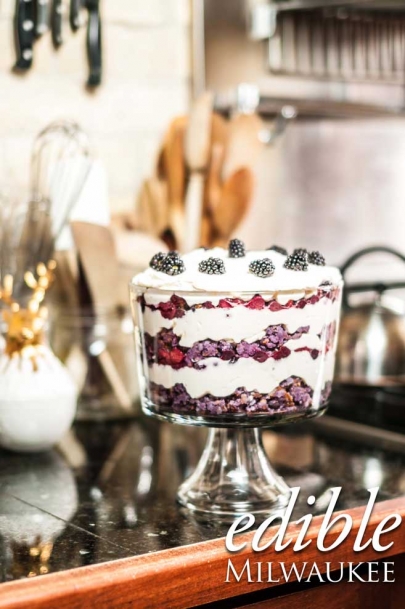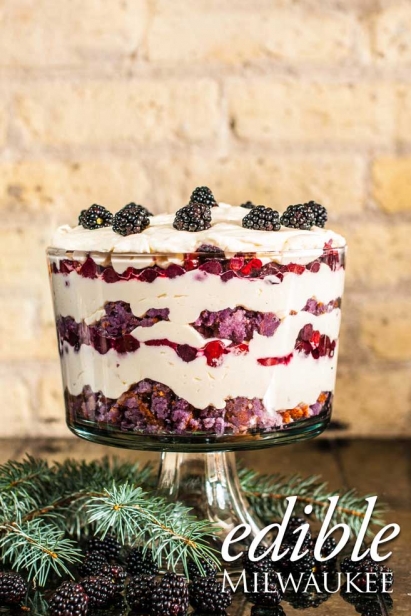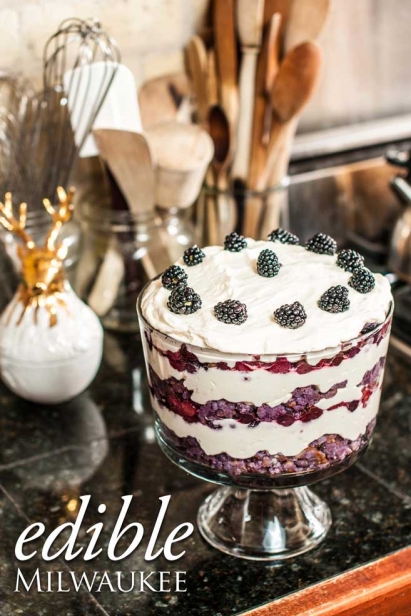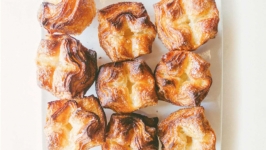The Easy Elegance of a Trifle
Trifle. The word is a McGuffin—a misleading name to throw you off the scent. You could not be blamed if you easily dismissed it as an abomination of Cool Whip and canned fruit. You’d be wrong.
The dessert often mocked as the worst excess of 1970s advertising pamphlets (and endlessly featured in online roundups of disgusting masses of gross gooey goop) is actually a delicate and elegant dessert.
Trifles have been done a great injustice. My mission is to redeem them! To put the trifle back on your holiday table in a place of honor to be admired and savored by all.
The origins of trifle are much more interesting than the poorly rendered color photos of the 1970s would have you believe. It is a dessert of nobility with many variations and wonderfully endless flexibility for the cook.
Traditionally thought of as wholly English, the trifle has many European cousins. In France, it’s referred to as a “charlotte.” When French chefs came to Moscow, it morphed into “Charlotte Russe.” In Italy, we see it as “tiramisu,” “cassata” and “Zuppa Inglese.” The pastry wizards of central Europe built towers of sweet bliss using the cake/booze/custard/fruit formula as evidenced by tortes by the thousands. We can even recognize the trifle antecedent in our most American of desserts, strawberry shortcake.
What is a Trifle?
Broken down to the essential elements, trifle is a stacked dessert of alcohol-soaked cake, custard and fruit. The magic is in how these elements dance together.
Let’s look at the cake layer first. “Cake,” as we know it today, is much different than the cake of previous centuries. It was not an overly sweetened confection, but rather lightly-sweetened bread similar to the modern brioche.
Freshly baked breads did not have the shelf life of modern bakery without the chemical preservatives. For that reason, many of the desserts originating in that era use stale breads or bread crumbs as a base. In the early 1800s, we see cooks creating “sponges,” something more akin to our modern idea of “cake.” This leads to our next essential element of trifle—alcohol.
Tradition holds that the cook would soak the stale bread in a fortified wine, like Port or Madeira. This evolved into brandy, then later to anything boozy! Today it is 100% acceptable to substitute a fruit juice for the alcohol.
The next, and very English, element is custard. England as a pastoral country had an easy supply of milk and eggs. Over the years, cooks have developed endless variations of combining those rich ingredients into many desserts. (One may ask whether the English sweet tooth was bred in the bone or taught from the cradle.) The custard used for trifle is “soft custard” and should be familiar to Milwaukeeans—it is also the base for our beloved frozen custard.
And the last element, fruit. Depending on the time of year, trifles can be adorned with fresh berries from the market or layered with the hearty fruits of fall. In winter, jarred fruits are used to great effect.
Making a Trifle
Preparing a trifle is more an exercise in assemblage than baking. Sure, you could make every single element from scratch, but we violate the spirit of trifle if we don’t take a few shortcuts. Our first step is to find the correct dish.
Trifles are most impressive when the layers are stacked ever higher. Because of the lovely, gooey nature of the dessert, it is not something that will hold shape without support. An ideal trifle bowl will be of clear glass and have tall sides. Often, they are on a pedestal to present the trifle in all its glory.
As mentioned earlier, choose your fruit first. You can use fresh or jarred fruits. Once that selection is made, choosing the “cake” is easy. Delicate fruits pair best with a light sponge cake, like angel food. More robust fruits match beautifully with a pound cake. And this is where you should most definitely be kind to yourself and purchase either of those cakes from your favorite purveyor.
You will want to plan ahead when making trifle, as you do need to let your cake dry out a bit. Leaving an open pound or angel food cake on your counter overnight, lightly covered with a flour cloth, will do the trick. Another option, which is the main ingredient in tiramisu, is ladyfinger-type cookies. Feel free to use your favorite.
Home cooks are often wary of making custard at home. I promise it is not as difficult as you may think. Essential here is a double boiler or a heaving metal mixing bowl and a smallish saucepan filled with boiling water. A hand whisk will make this process a breeze. Heat the egg and sugar mixture over the boiling water until the sugar is dissolved. Fold in the milk or cream and continue to whisk. As the mixture comes to a near boil, it will begin to thicken. As it does, remove from heat and continue to stir.
At this point, you can flavor your custard a thousand different ways. You can add a touch of vanilla extract for simple vanilla custard. Adding a jar of lemon or lime curd is an easy way to give the custard a citrusy zing. A favorite method of mine, with a nod to the historic use of gelatin, is to stir in a jam or jelly of a complementary flavor to the chosen fruit. A few tablespoons of strawberry jam or orange marmalade added to the custard is an easy way to add to the “wow” factor.
As a topping to your trifle, you must have whipped cream. This is another ingredient that is rewarded by making it yourself versus buying a premade product. (And please, Cool Whip is never the answer when it comes to whipped cream!) We may have memories of fetching whisks out of the freezer and developing arm cramps trying to whip it by hand. No more! I have an easy solution for you. Of course, if you have a stand mixer, that makes whipping cream a breeze. Heavy cream, a dash of vanilla and a few tablespoons of powdered sugar, and you’re more than halfway there.
But you can do this by hand. Place all the aforementioned ingredients in a clean 1 or 2-quart Mason jar (depending on how much whipped cream you’re making). Place a lid on tightly and … shake! Careful, or you’ll end up with butter. But a few minutes of vigorous shaking will give a jar filled with lovely whipped cream.
After you’ve prepped your individual elements, begin assembly. Tear your cake into bite-sized pieces and soak in alcohol for about five minutes. Then, begin layering the soaked cake into the bottom of the bowl. Then add the custard, the fruit, and continue until all ingredients are used. Add your whipped cream and place a few pieces of fruit on top for decoration. You’ll want to cover with a piece of parchment or plastic wrap and place into the fridge for at least 2 hours. The trifle can also be made the day before and remain in the refrigerator for up to 24 hours.
I do hope that you’ll consider adding a trifle to your holiday dessert table. It’s a nod to tradition that deserves to be welcomed back.








